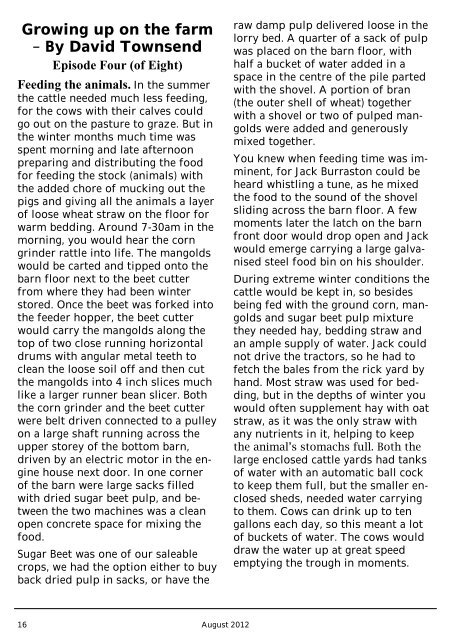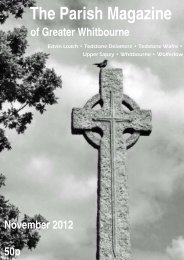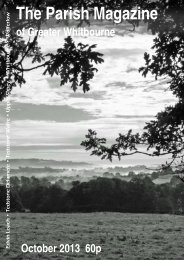click - Parish of Greater Whitbourne
click - Parish of Greater Whitbourne
click - Parish of Greater Whitbourne
- No tags were found...
You also want an ePaper? Increase the reach of your titles
YUMPU automatically turns print PDFs into web optimized ePapers that Google loves.
Growing up on the farm– By David TownsendEpisode Four (<strong>of</strong> Eight)Feeding the animals. In the summerthe cattle needed much less feeding,for the cows with their calves couldgo out on the pasture to graze. But inthe winter months much time wasspent morning and late afternoonpreparing and distributing the foodfor feeding the stock (animals) withthe added chore <strong>of</strong> mucking out thepigs and giving all the animals a layer<strong>of</strong> loose wheat straw on the floor forwarm bedding. Around 7-30am in themorning, you would hear the corngrinder rattle into life. The mangoldswould be carted and tipped onto thebarn floor next to the beet cutterfrom where they had been winterstored. Once the beet was forked intothe feeder hopper, the beet cutterwould carry the mangolds along thetop <strong>of</strong> two close running horizontaldrums with angular metal teeth toclean the loose soil <strong>of</strong>f and then cutthe mangolds into 4 inch slices muchlike a larger runner bean slicer. Boththe corn grinder and the beet cutterwere belt driven connected to a pulleyon a large shaft running across theupper storey <strong>of</strong> the bottom barn,driven by an electric motor in the enginehouse next door. In one corner<strong>of</strong> the barn were large sacks filledwith dried sugar beet pulp, and betweenthe two machines was a cleanopen concrete space for mixing thefood.Sugar Beet was one <strong>of</strong> our saleablecrops, we had the option either to buyback dried pulp in sacks, or have theraw damp pulp delivered loose in thelorry bed. A quarter <strong>of</strong> a sack <strong>of</strong> pulpwas placed on the barn floor, withhalf a bucket <strong>of</strong> water added in aspace in the centre <strong>of</strong> the pile partedwith the shovel. A portion <strong>of</strong> bran(the outer shell <strong>of</strong> wheat) togetherwith a shovel or two <strong>of</strong> pulped mangoldswere added and generouslymixed together.You knew when feeding time was imminent,for Jack Burraston could beheard whistling a tune, as he mixedthe food to the sound <strong>of</strong> the shovelsliding across the barn floor. A fewmoments later the latch on the barnfront door would drop open and Jackwould emerge carrying a large galvanisedsteel food bin on his shoulder.During extreme winter conditions thecattle would be kept in, so besidesbeing fed with the ground corn, mangoldsand sugar beet pulp mixturethey needed hay, bedding straw andan ample supply <strong>of</strong> water. Jack couldnot drive the tractors, so he had t<strong>of</strong>etch the bales from the rick yard byhand. Most straw was used for bedding,but in the depths <strong>of</strong> winter youwould <strong>of</strong>ten supplement hay with oatstraw, as it was the only straw withany nutrients in it, helping to keepthe animal’s stomachs full. Both thelarge enclosed cattle yards had tanks<strong>of</strong> water with an automatic ball cockto keep them full, but the smaller enclosedsheds, needed water carryingto them. Cows can drink up to tengallons each day, so this meant a lot<strong>of</strong> buckets <strong>of</strong> water. The cows woulddraw the water up at great speedemptying the trough in moments.16 August 2012
















